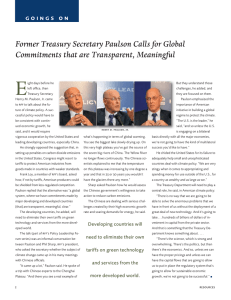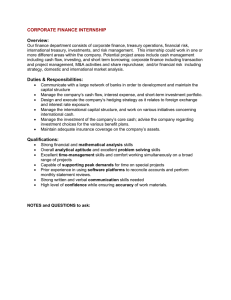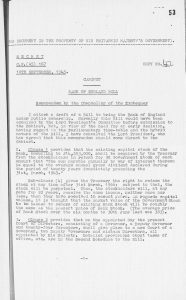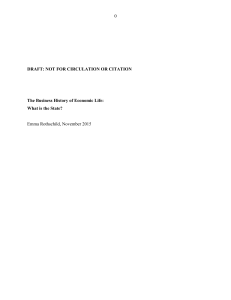September 25, 2008 Bagehot plus RFC: the right financial fix
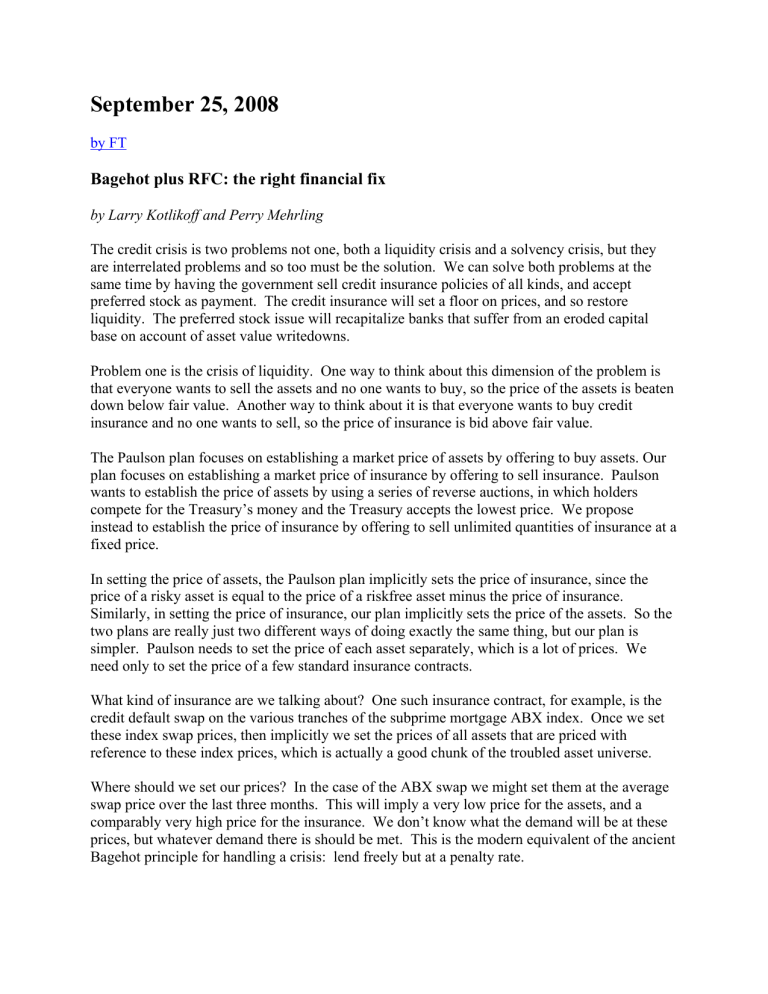
September 25, 2008 by FT
Bagehot plus RFC: the right financial fix
by Larry Kotlikoff and Perry Mehrling
The credit crisis is two problems not one, both a liquidity crisis and a solvency crisis, but they are interrelated problems and so too must be the solution. We can solve both problems at the same time by having the government sell credit insurance policies of all kinds, and accept preferred stock as payment. The credit insurance will set a floor on prices, and so restore liquidity. The preferred stock issue will recapitalize banks that suffer from an eroded capital base on account of asset value writedowns.
Problem one is the crisis of liquidity. One way to think about this dimension of the problem is that everyone wants to sell the assets and no one wants to buy, so the price of the assets is beaten down below fair value. Another way to think about it is that everyone wants to buy credit insurance and no one wants to sell, so the price of insurance is bid above fair value.
The Paulson plan focuses on establishing a market price of assets by offering to buy assets. Our plan focuses on establishing a market price of insurance by offering to sell insurance. Paulson wants to establish the price of assets by using a series of reverse auctions, in which holders compete for the Treasury’s money and the Treasury accepts the lowest price. We propose instead to establish the price of insurance by offering to sell unlimited quantities of insurance at a fixed price.
In setting the price of assets, the Paulson plan implicitly sets the price of insurance, since the price of a risky asset is equal to the price of a riskfree asset minus the price of insurance.
Similarly, in setting the price of insurance, our plan implicitly sets the price of the assets. So the two plans are really just two different ways of doing exactly the same thing, but our plan is simpler. Paulson needs to set the price of each asset separately, which is a lot of prices. We need only to set the price of a few standard insurance contracts.
What kind of insurance are we talking about? One such insurance contract, for example, is the credit default swap on the various tranches of the subprime mortgage ABX index. Once we set these index swap prices, then implicitly we set the prices of all assets that are priced with reference to these index prices, which is actually a good chunk of the troubled asset universe.
Where should we set our prices? In the case of the ABX swap we might set them at the average swap price over the last three months. This will imply a very low price for the assets, and a comparably very high price for the insurance. We don’t know what the demand will be at these prices, but whatever demand there is should be met. This is the modern equivalent of the ancient
Bagehot principle for handling a crisis: lend freely but at a penalty rate.
That brings us to problem two, the crisis of solvency. By setting the price of insurance we establish a price of assets, which may well be below the value at which financial institutions are carrying these assets on their books. Mark the assets to market and you make the solvency problem worse. That’s the biggest problem with the Paulson plan (unless he overpays for the assets, and that raises additional political problems). In our plan, we solve the solvency problem by letting buyers of credit insurance pay for that insurance with preferred stock.
The result is that, after buying insurance from the government, buyers will be able to carry the assets at par, or sell them at par (by packaging them with the insurance) in order to raise cash.
Either way the value of their assets will be marked up by the value of the insurance, and that markup is also the amount of recapitalization. Both problems are solved at the same time.
But what about the taxpayer’s exposure? In Paulson’s plan, the Treasury borrows $700 billion by issuing Treasury bills and bonds, and using the proceeds to acquire a huge portfolio of dodgy mortgage backed securities. In our plan, the Treasury issues credit insurance policies and uses the proceeds to acquire an equity stake in troubled financial institutions.
Looking forward in time, under Paulson’s plan, the Treasury holds the dodgy assets to maturity, or until the underlying housing market recovers enough that the securities can be sold, with the proceeds used to redeem the Treasury borrowing. In our plan, the Treasury holds preferred shares until such time as the financial institutions recover profitability and use those profits to repay the Treasury stake.
This second dimension of our plan is the modern equivalent of the mechanism used by the
Reconstruction Finance Corporation in the Great Depression. Bagehot plus RFC is the right financial fix.
Larry Kotlikoff is professor of economics at Boston University. Perry Mehrling is professor of economics at Barnard College, Columbia University
